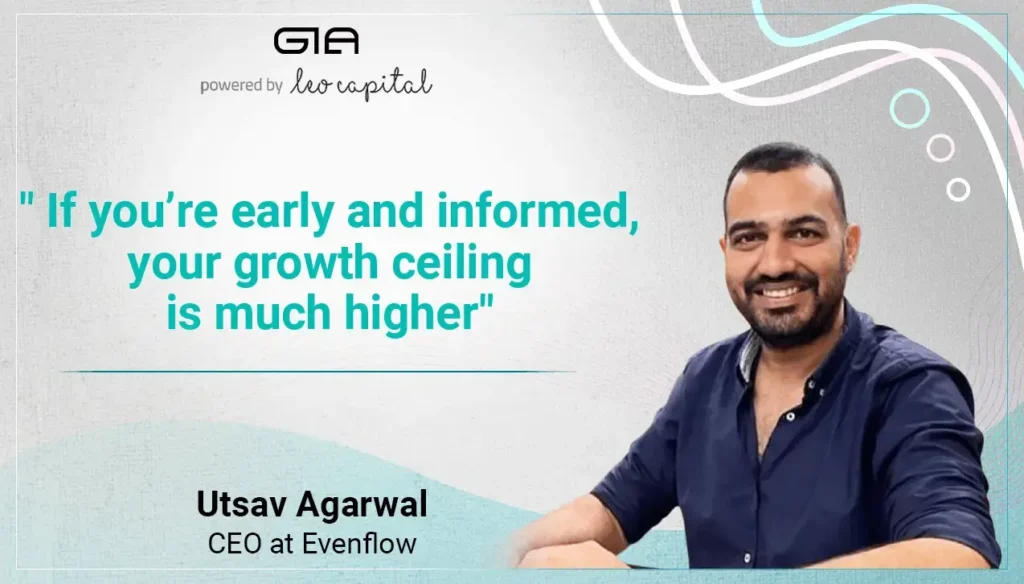When Utsav Agarwal launched Evenflow, a house of brands built for global e-commerce platforms, in April 2021, the world was deep in its second COVID wave. But this wasn’t a spur-of-the-moment bet. Before writing a single cheque, Utsav cold-called over 250 sellers to understand how India’s fragmented e-commerce ecosystem really worked, from sourcing and margins to marketing and fulfilment.
He then bootstrapped operations, avoided the capital-at-all-costs trap, and built a disciplined, profitable business that runs international operations across Amazon, Walmart, and Noon, all from a 35-member team in Bangalore.
In this GIA conversation, Utsav shares what it takes to build lean, scale smart, and take Indian-built brands global.
1. What drew you to the idea of Evenflow, and how did you validate it?
The idea came from an article a friend shared with me in October 2020 about Thrasio. At the time, I wasn’t actively looking to start up. But I was curious.
I spent the next few months speaking to over 250 sellers, most of them Amazon-first brands.
It was surprisingly easy to get their numbers, set up calls, and dig deep into how they operated: sourcing, marketing, logistics, pricing, categories.
That research phase gave me clarity on where the real value lay and what to avoid. By February 2021, I was convinced. Even though other players were entering the space, I knew the work I’d done was real. We officially launched in April 2021.
2. You’ve deliberately stayed away from raising large amounts of capital. Why?
We’ve always been conservative with capital, both equity and debt. While most global and Indian roll-up players used heavy leverage, we funded our first set of acquisitions entirely through equity. In hindsight, that was the right call.
September 2022 was a turning point. We were running out of cash, and the funding winter had kicked in. That forced us back to the drawing board, rewire how we thought about the business, toil excruciatingly hard, and turn the business profitable. We went from a $250K monthly burn with 60 people to a profitable business with 35 people. I believe if capital had been easily available, we would have continued making the same top-line-first mistakes.
3. How do you decide which categories and brands to go after?
We started with a “negative list”, categories we didn’t want to touch:
- Apparel- high returns, low predictability
- Electronics- warranty and service-heavy
- Skincare- high CAC, intense competition
- Perishables- expiry risk, complex supply chains
This naturally led us to categories like home & kitchen, lawn & garden, sports & fitness, and baby safety. Over time, we acquired 7 brands. Initially, we thought we’d scale 100 brands. But post-integration, we realised operationally it made more sense to scale 7 deeply rather than 100 thinly.
A ₹150 crore brand is better than 15 ₹10 crore ones.
4. How do you operate across multiple global platforms, Amazon US, Walmart, Noon, with a lean team based in India?
The existing e-commerce infrastructure today makes this possible. Platforms like Amazon, Walmart, and Noon are built to let you sell from anywhere.
We operate in the US, MENA, and soon Australia and Europe, all from a single office in Bangalore.
We don’t have local teams on the ground. We rely on strong relationships and tight information flow. Our sourcing is almost entirely from India. We use local and global partners to get access to new verticals, business & know-how. For instance, our warehousing partner does warehousing and international freight for one of the FAANG companies. Go figure 🙂
5. What does the India advantage mean for Evenflow?
India teaches you to hustle. It’s chaotic, nonlinear, unpredictable. If you learn to operate here, you build a muscle that helps you scale elsewhere.
India also gives us access to incredibly diverse talent. Someone at ₹6 LPA and someone at ₹80 LPA can both do the same job, if chosen right.
The key is to spot undiscovered talent and scale them. That’s our hiring strategy now: we look for curiosity, intent, and basic mental math skills. Everything else can be taught.
6. You’ve spoken a lot about your hiring learnings. What are the non-negotiables for your team?
We screen for three things:
- Curiosity- Can they talk passionately about anything for 10 minutes?
- Intent- We give an assignment with a 48-hour deadline. We don’t entertain late submissions.
- Mental math- Because over-relying on Excel blinds you to outliers.
We’ve also learned not to hire based on pedigree. Early on, we went after top institutes and resumes. That didn’t work. Today, our team is sharper, leaner, and more outcome-focused, and payroll has dropped by 60% while revenue has doubled.
7. How do you manage demand forecasting and inventory across categories and geographies?
We’ve built strong sourcing and forecasting muscles. Take hosepipes, one of our best sellers. Demand spikes from mid-Feb to May and drops off after. We need to be in stock before the season and taper off just in time to avoid overstock.
Platforms like Amazon or Blinkit penalize you (via visibility loss) if you go out of stock. So inventory planning is critical and the backbone for our business.
You can’t talk about inventory without referring to warehousing & logistics – they are intertwined. Our manufacturing partners act as hubs for us, always keeping a certain pre-aligned buffer stock that is ready to be shipped at 24 hours notice.
And all of this is possible as our sourcing is primarily focussed on India – except 5-6 SKUs; we don’t like doing China.
8. How do you identify new international markets to enter?
We look at four filters:
- Market size- Amazon US is so big, even a 0.01% share is meaningful.
- Platform access- Do we have the right connects or insider knowledge to move fast?
- Product fit- Is there pricing/review arbitrage we can leverage?
- Compliance- Can we navigate taxes, VATs, and documentation without adding friction?
Some moves are partner-led; our entry into MENA was one such case. We’re now exploring Amazon Australia, simply because it’s early and less crowded.
If you’re early and informed, your growth ceiling is much higher.
9. What advice would you give Indian founders who want to build global businesses from here?
Don’t overthink it. Today, it’s easier than ever to sell globally without setting up a local office.
For e-commerce, the pipes are already built; you just need to plug in.
If you’re entering a new market, do what I did at Uber and Glovo: a ‘greenlight’ trip. Spend a week, meet 20 local founders, get the lay of the land. Those early connects will help you recruit, incorporate, and grow. And if you’re good at cold outreach, even better. Most of our early partners came from a cold WhatsApp or LinkedIn message. The trick? Follow up within 48 hours. That alone increases your response rate by 70%.

